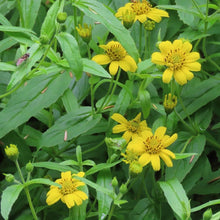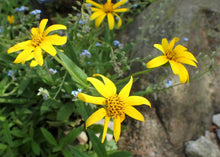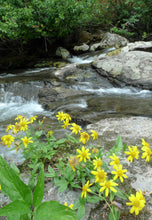Arnica lanceolata ssp prima (syn Arnica amplexicaulis)
Streambank or clasping arnica is a perennial wildflower with cheerful yellow, daisy-like blooms in late spring or early summer. It grows from a small rhizome that produces hairy stems that can get over two feet tall with oval to lanced-shaped leaves that clasp the stem in opposite pairs. The flowers will attract and support neighborhood bumblebees.
- Plant type/canopy layer: deciduous, perennial, herbaceous plant
- Size at maturity: 12-30” tall, equally wide
- Light requirements: full sun to part shade
- Moisture requirements: moist to seasonally wet soil
- Bloom time: May - August (May - July in the Portland metro area)
- Growth rate/ease: moderate growth rate, moderately difficult to grow since it requires a site with ample moisture
- Wildlife support: flowers are used by several species of bumblebees
- Native habitat/range: grows on wet rocky slopes, wet meadows, gravel bars, streambanks and marshes in most western, moister counties of the Pacific Northwest from Alaska, through western British Columbia, Washington, Oregon and into northern California, as well as some of the less arid areas of Idaho and Nevada. Portland Plant List - yes.
- Special features & uses: many species within this genus are commonly used in traditional medicine. Even today, Arnica products can be readily sourced in the first aid section of natural grocers. It is primarily used topically, in the form of creams, oil, salve, or liniment, to reduce inflammation, and to help heal soft tissue injuries such as bruises, sprains and strains.
Gardening with Streambank Arnica: Be sure to give this beauty the moisture it needs by planting it in a wet wildflower meadow or other bog-like area of your landscape. Consider companion planting in multiples with other moisture loving, pollinator-favorites such as blue-eyed grass, purple monkey flower, and Oregon saxifrage. Depending on soil moisture, it will likely require supplemental moisture during the summer drought.
Photo Credit 1: "Arnica amplexicaulis" by Erin Springinotic is marked with CC0 1.0.
Photo Credit 2: "Aruncus dioicus" by Joan Simon is licensed under CC BY-SA 2.0
Photo Credit 3: "Aruncus dioicus" by wallygrom is licensed under CC BY-SA 2.0






